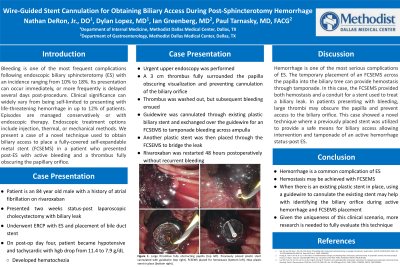Monday Poster Session
Category: Biliary/Pancreas
P1502 - Wire-Guided Stent Cannulation for Obtaining Biliary Access During Post-Sphincterotomy Hemorrhage
Monday, October 23, 2023
10:30 AM - 4:15 PM PT
Location: Exhibit Hall

Has Audio

Nathan DeRon, Jr., DO
Methodist Health System of Dallas
Dallas, TX
Presenting Author(s)
Nathan DeRon, DO1, Dylan Lopez, MD1, Ian Greenberg, MD1, Paul Tarnasky, MD2
1Methodist Health System of Dallas, Dallas, TX; 2Methodist Dallas Medical Center, Dallas, TX
Introduction: Bleeding is one of the most frequent complications following endoscopic biliary sphincterotomy (ES), with an incidence ranging from 10% to 18%. Its presentation can occur immediately, or more frequently is delayed several days post-procedure. Clinical significance can widely vary from being self-limited to presenting with life-threatening hemorrhage in up to 12% of patients. Episodes are managed conservatively or with endoscopic therapy. Endoscopic treatment options include injection, thermal, or mechanical methods. We present a case of a novel technique used to obtain biliary access to place a fully-covered self-expandable metal stent (FCSEMS) in a patient who presented post-ES with active bleeding and a thrombus fully obscuring the papillary orifice.
Case Description/Methods: An 84-year-old male with a history of atrial fibrillation on rivaroxaban underwent ERCP with ES and placement of a bile duct stent for a biliary leak that presented two weeks after laparoscopic cholecystectomy. Anticoagulation was held. On post-operative day four, he became hypotensive and tachycardic with an acute decrease in hemoglobin from 11.4 to 7.9 g/dL and hematochezia. Urgent endoscopy was performed. In the duodenum, blood was present, and a 3 cm thrombus fully surrounded the papilla obscuring visualization and preventing cannulation of the biliary orifice. Washing was performed to dislodge the thrombus, but active bleeding ensued from. To gain access, a guidewire was cannulated through the plastic biliary stent. The stent was then removed and, over the guidewire, a FCSEMS was deployed to tamponade bleeding across the ampulla. Lastly, a plastic stent was replaced through the FCSEMS to bridge the leak. The patient was restarted on his rivaroxaban after 48 hours and had no recurrent bleeding.
Discussion: Hemorrhage is one of the most serious complications of ES. The temporary placement of an FCSEMS across the papilla into the biliary tree can provide hemostasis through tamponade. In this case, the FCSEMS provided both hemostasis and a conduit for a stent used to treat a biliary leak. In patients presenting with bleeding, large thrombi may obscure the papilla and prevent access to the biliary orifice. This case showed a novel technique where a previously placed stent was utilized to provide a safe means for biliary access allowing intervention and tamponade of an active hemorrhage status-post ES.
Disclosures:
Nathan DeRon, DO1, Dylan Lopez, MD1, Ian Greenberg, MD1, Paul Tarnasky, MD2. P1502 - Wire-Guided Stent Cannulation for Obtaining Biliary Access During Post-Sphincterotomy Hemorrhage, ACG 2023 Annual Scientific Meeting Abstracts. Vancouver, BC, Canada: American College of Gastroenterology.
1Methodist Health System of Dallas, Dallas, TX; 2Methodist Dallas Medical Center, Dallas, TX
Introduction: Bleeding is one of the most frequent complications following endoscopic biliary sphincterotomy (ES), with an incidence ranging from 10% to 18%. Its presentation can occur immediately, or more frequently is delayed several days post-procedure. Clinical significance can widely vary from being self-limited to presenting with life-threatening hemorrhage in up to 12% of patients. Episodes are managed conservatively or with endoscopic therapy. Endoscopic treatment options include injection, thermal, or mechanical methods. We present a case of a novel technique used to obtain biliary access to place a fully-covered self-expandable metal stent (FCSEMS) in a patient who presented post-ES with active bleeding and a thrombus fully obscuring the papillary orifice.
Case Description/Methods: An 84-year-old male with a history of atrial fibrillation on rivaroxaban underwent ERCP with ES and placement of a bile duct stent for a biliary leak that presented two weeks after laparoscopic cholecystectomy. Anticoagulation was held. On post-operative day four, he became hypotensive and tachycardic with an acute decrease in hemoglobin from 11.4 to 7.9 g/dL and hematochezia. Urgent endoscopy was performed. In the duodenum, blood was present, and a 3 cm thrombus fully surrounded the papilla obscuring visualization and preventing cannulation of the biliary orifice. Washing was performed to dislodge the thrombus, but active bleeding ensued from. To gain access, a guidewire was cannulated through the plastic biliary stent. The stent was then removed and, over the guidewire, a FCSEMS was deployed to tamponade bleeding across the ampulla. Lastly, a plastic stent was replaced through the FCSEMS to bridge the leak. The patient was restarted on his rivaroxaban after 48 hours and had no recurrent bleeding.
Discussion: Hemorrhage is one of the most serious complications of ES. The temporary placement of an FCSEMS across the papilla into the biliary tree can provide hemostasis through tamponade. In this case, the FCSEMS provided both hemostasis and a conduit for a stent used to treat a biliary leak. In patients presenting with bleeding, large thrombi may obscure the papilla and prevent access to the biliary orifice. This case showed a novel technique where a previously placed stent was utilized to provide a safe means for biliary access allowing intervention and tamponade of an active hemorrhage status-post ES.
Disclosures:
Nathan DeRon indicated no relevant financial relationships.
Dylan Lopez indicated no relevant financial relationships.
Ian Greenberg indicated no relevant financial relationships.
Paul Tarnasky indicated no relevant financial relationships.
Nathan DeRon, DO1, Dylan Lopez, MD1, Ian Greenberg, MD1, Paul Tarnasky, MD2. P1502 - Wire-Guided Stent Cannulation for Obtaining Biliary Access During Post-Sphincterotomy Hemorrhage, ACG 2023 Annual Scientific Meeting Abstracts. Vancouver, BC, Canada: American College of Gastroenterology.
